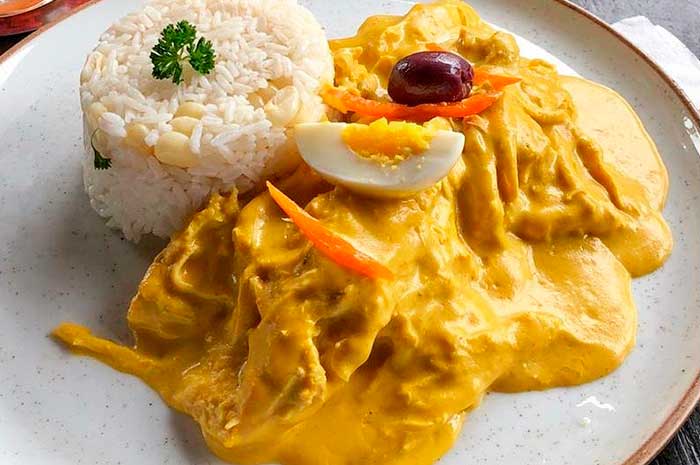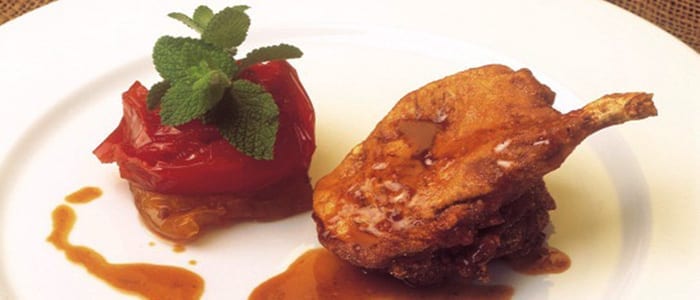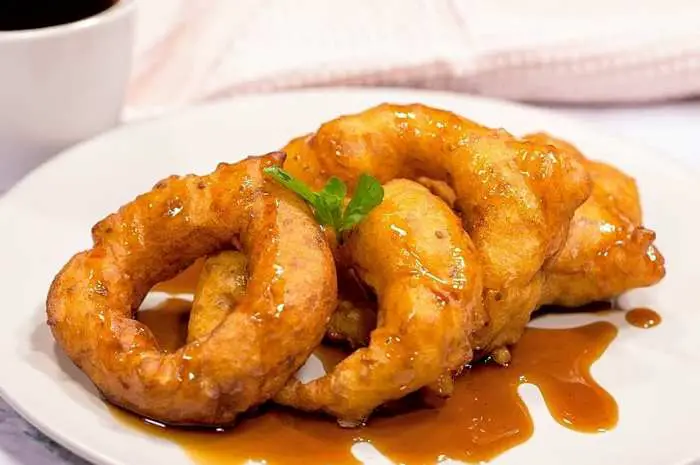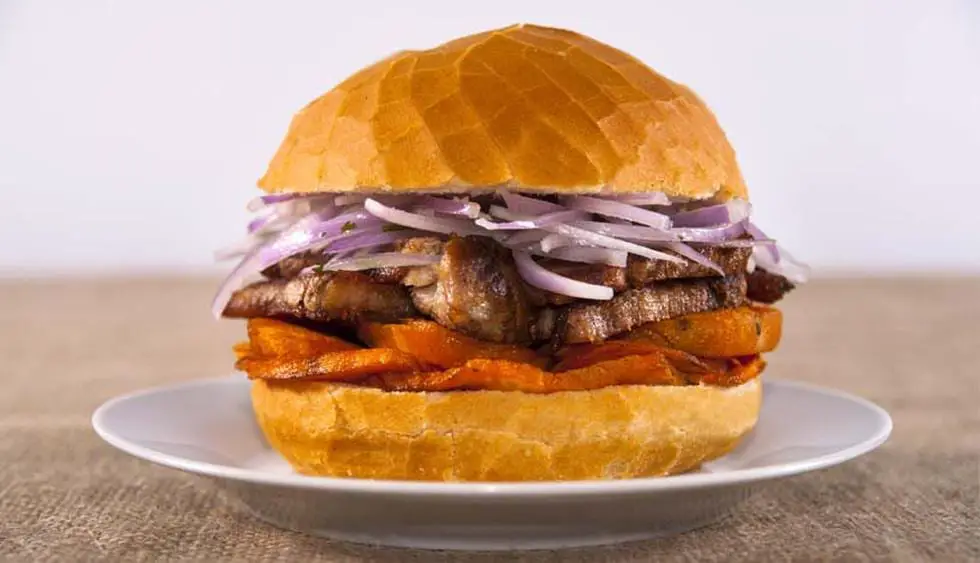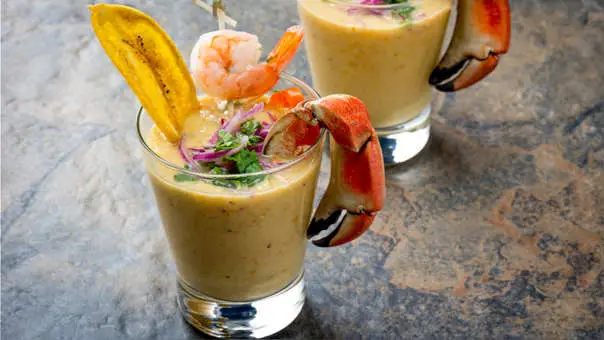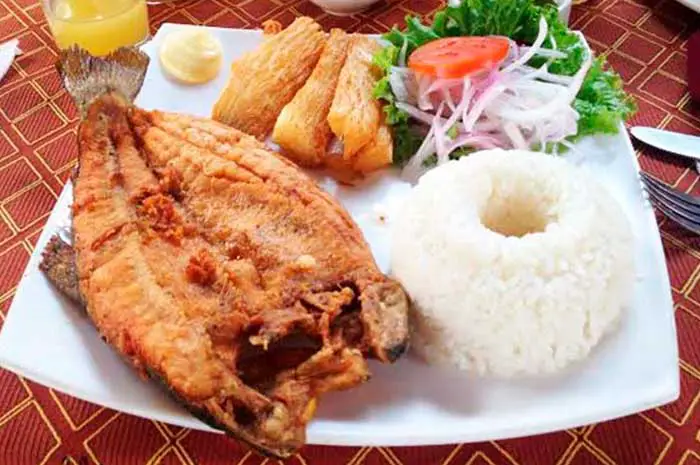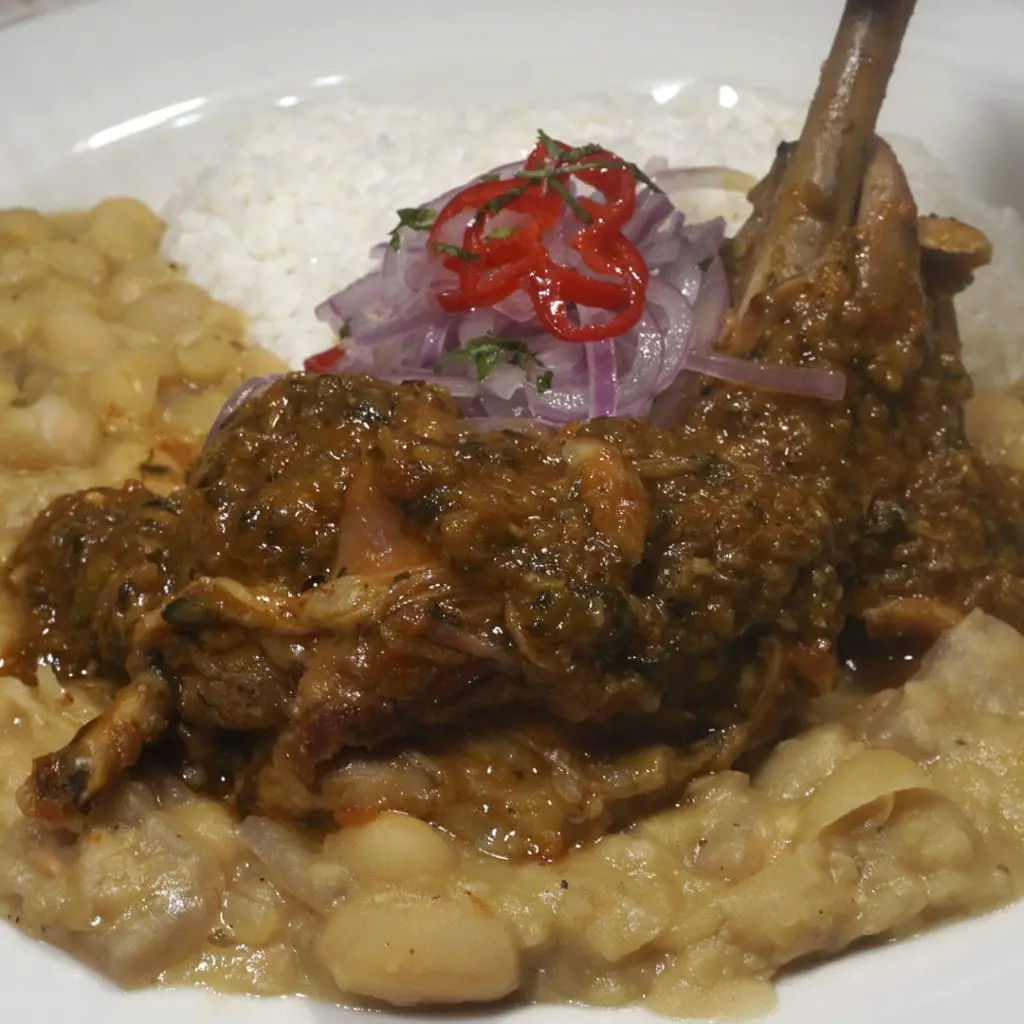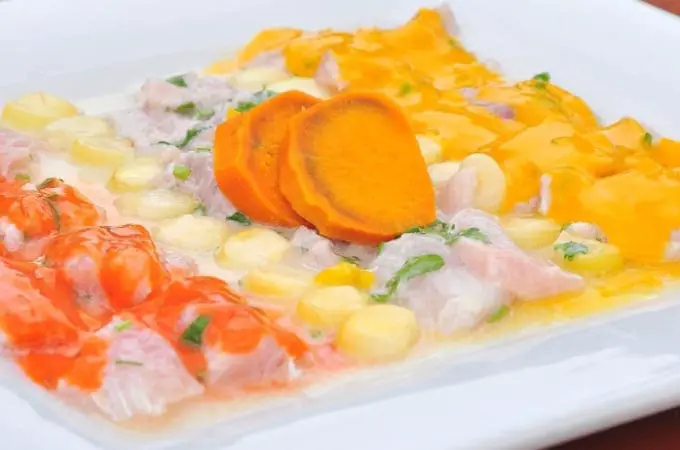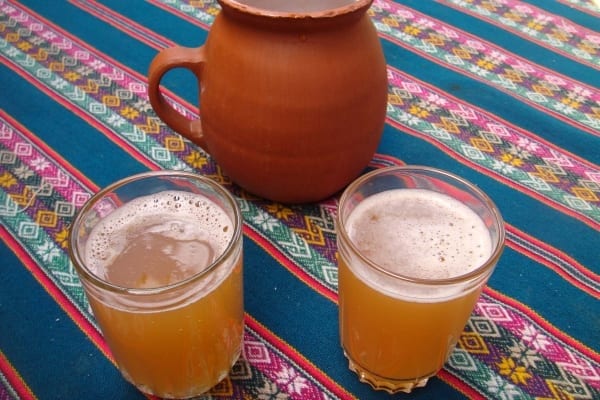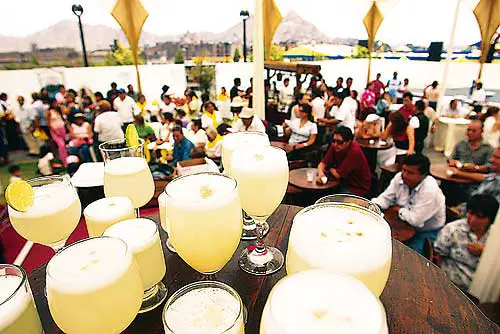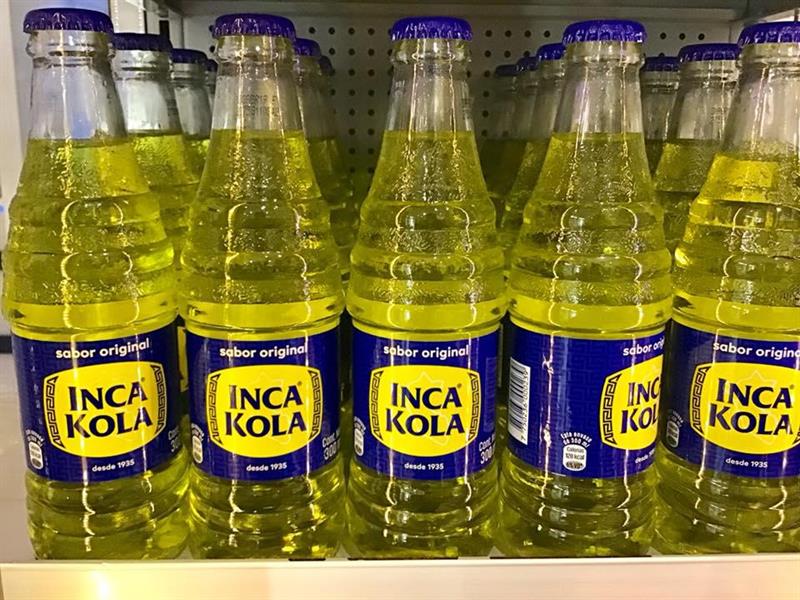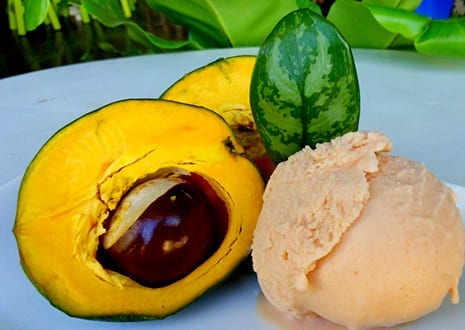28 Traditional Peruvian Foods to Try
James Bustamante is Native to New York but born to Peruvian parents. He has been traveling throughout Latin America since early 2003 and finally made his home in Peru. James has made his way by eating and traveling through almost every country in Central and South America.
Last Updated on January 11, 2021 by James Bustamante
There are several dishes of traditional Peruvian food you must try while on your trip to this amazing country.
It is not enough to simply secure your Machu Picchu hike and then just assume you did all the “Peru stuff” most people do during their trip.
Below we have a list of traditional Peruvian food items to put on your bucket list in no particular order.
Aji de Gallina
Aji de gallina has always been a crowd favorite among the long lists of traditional Peruvian food you have to try.
This dish is a traditional Peruvian stew made with chicken and yellow chili peppers, nuts, turmeric, garlic, and other spices.
This dish also uses bread to make the sauce, it gives it a thickening factor and helps to suck up all the deliciousness from the other ingredients.
You can find this Peruvian food coupled with hard-boiled eggs, usually as a decoration.
The story goes as follows, the Aji de Gallina recipe we know today comes from a Spanish dish called Manjar Blanco or “Menjar Blanc” which originates in the year XIV.
The original Spanish recipe describes a sweet dish made of the breast of a hen, rice, almonds, and milk on occasions.
As time progressed the Menjar Blanc eventually discontinued the use of hen and became a dessert that is served cold.
This delicious traditional dish is also said to have been introduced into Peruvian cuisine by African slaves.
The truth probably lies somewhere in the middle or could be a mix of both.
When you first set your eyes on this yellow dish the visuals coupled with the aromas give of a flavor-packed dish.
The yellow chili peppers have been prepared in a way to not make overly spice so don’t count this dish out in case you aren’t good with heat.
Full Aji de Gallina Recipe: https://www.journeymachupicchu.com/aji-de-gallina-recipe/
Alpaca Steak

Have you ever wondered whether you can actually eat an Alpaca? Probably not, but while in Peru you will.
Once you arrive at the highlands you will run into restaurants offering Alpaca meat in their dishes.
This is a traditional Peruvian food you will find in places like Arequipa, Cusco, or Puno.
These fluffy little animals are for their precious wool as well as for their high protein meat.
There are people who will try to compare them to beef steaks but if you wanted to have a comparison to something that is currently eaten in the USA, I would say they taste more like Elk.
Alpaca steaks are very lean so if you are looking for a high protein, low-fat meat alternative by all means try the Alpaca.
Yes, they are cute but remember that they are an animal the locals have worked with for centuries.
They are used for their expensive wool to make textiles, as porters during hikes, and lastly for consumption.
Want to try the delicious Alpaca steak in the picture? They try them out as well as other Andean delicacies at the Cicciolina in Cusco.
Cicciolina: http://www.cicciolinacuzco.com
Arroz con Pato
This traditional Peruvian food is a rice-based dish served with duck. Arroz con Pato emanates from the northern Peruvian region of Chiclayo.
A little known fact is that ducks are native to Peru, the northern cultures used duck for many traditional dishes.
When the Spanish conquered Peru they also brought items such as onions, rice, cilantro, and several other ingredients you can find in this green colored dish.
This traditional northern delicacy can be found in several places throughout the country nowadays but the origin will always be from Chiclayo.
There are also several variations of this dish, one is “arroz con pollo” which simply replaces the traditional duck with chicken.
This Peruvian food is green due to the spinach and cilantro used to make the sauce for the rice. Try it with a traditional Peruvian onion salad and some “aji”.
Causa Rellena
Causa rellena is a traditional dish that comes with plenty of history from Peru. Peruvian Causa is a typical dish enjoyed by Peruvians.
It is often served during lunchtime as an entree but on some occasions, it can be the main course. Causa rellena uses as a base the delicious Peruvian yellow potato, due to its texture it makes it a nearly perfect potato for mashing into a paste.
It is a delicious dish that can be quickly prepared and is stuffed with just about anything from chicken to shrimp, tuna, vegetables, and even octopus.
There has always been quite the debate or the origins of Causa Rellena. The main two theories consider the name coming from “The Protector of Peru” Jose de San Martin.
The origin of the Peruvian Causa name has been up for debate. There are mainly two theories on its origins.
Many consider the name to come from Jose de San Martin, also known as the protector of Peru.
To Peruvians, the story behind the food is almost as important as the food itself so learning about it should be part of everybody’s Machu Picchu Travel itinerary. Hey, food is important in Peru.
Causa Rellena basically translates to the stuffed cause which from an outside view, makes no sense.
Consider the Pacific war between Peru and Chile. Food supplies in Peru were low but there were plenty of potatoes.
The women were said to go around the various villages picking up potatoes and whatever else they could find.
These women would then prepare this potato mash stuffed with the various vegetables they were able to get.
They would then give them to the soldiers as food and say it was for the cause or “causa”, stuffed cause = “Causa Rellena”. Voila! A delicious traditional Peruvian food was born.
Get the Full Recipe Here: https://www.journeymachupicchu.com/how-to-make-peruvian-causa/
Anticuchos
The first sense you feel will be your sense of smell, you might be over a block away from the “Anticucheria” but you will definitely still smell them.
This traditional Peruvian food might seem like the typical skewered meat but it is anything but that.
First off, Anticuchos are made with cow hearts. Yes, marinated cow hearts, and they are absolutely delicious. The Anticucho is famous Peruvian street food for several reasons.
For starters, the meat is very tender and flavorful. Nothing at all what you would expect from biting into a cow heart.
This Peruvian food originated in the Andes region of the country and has been a favorite among the many corners in Lima streets for many years.
They are severed with potatoes, Andean corn and all the Aji (Peruvian hot sauce – there are many varieties) you can take.
Caldo De Gallina
Caldo de gallina translates to hen soup. This traditional food is actually one of the oldest ones.
The origin of this dish is somewhat unknown mainly because there seem to be several origin stories.
Some speculate that the locals were making Caldo de Gallina or a variation of today’s dish for a very long time. There are other historians that believe the dish came to Peru with Chinese workers and merged with local products.
This traditional Peruvian dish is made with a hen (not chicken) because of the strong flavor profile. There is also the addition of noodles, usually, a thick noodle is used.
Eggs are also added to the soup as well as potatoes and scallions. This broth is made by slow-cooking the hen for several hours in order to get as much flavor as possible.
Do not think this is similar to a Caldo de Pollo or chicken soup. The flavor profiles are very different and your regular everyday chicken soup will taste bland after trying this delicious, traditional Peruvian food.
Cuy Chactado
Now let’s get into one of the more obscure, traditional Peruvian foods you have to try. The “Cuy” is commonly known in other countries as the fluffy guinea pig.
Yes, the same guinea pigs you have always known as friendly pets are eaten in Peru.
To specify the guinea pigs you’ll see in Peru are much larger and have been raised in a guinea pig farm (yes, really!), fed an organic diet, and had enough space to be a very happy little rodent.
Cuy Chactado is a delicacy from the highland region, it is a friend cuy split through the middle. The result is a crispy outside with flavorful fatty inside.
It is usually served with fried, sliced potatoes and an onion salad. The Inca were very fond of this nutritious meat and were eating cuy way before the Spanish arrived.
These little animals were very easy to breed so the locals in the highlands preferred them to beef.
Picarones
We now go from the more obscure to a very sweet traditional Peruvian food. Picarones are often referred to as Peruvian donuts but they are so much more and can be more satisfying as well.
These round fried pastries are made from the “Zapallo Macre” a type of Peruvian squash and sweet potato mixture.
The dough itself is very sweet and up to this point rather healthy if you think about it.
We then add cinnamon, sugar, flour, salt, and yeast. They are then fried until they reach a crispy texture on the outside while remaining soft and moist on the inside.
Picarones are served with a syrup made from “chancaca” a type of blackstrap molasses, cinnamon, orange zest, figs, and pineapple. The result is a sweet traditional Peruvian dessert you really must try.
Rocoto Relleno
Next on our list of Peruvian foods, you have to try is a crowd favorite among international travelers.
The Rocoto Relleno or stuffed pepper might seem like any stuffed pepper you’ve seen or made before.
The rocoto is a Peruvian chili pepper that can range from 50,000 – 250,000 units on the Scoville scale.
Don’t let those numbers scare you off this dish though, the Rocoto is prepared in a way as to reduce the heat it produces and the end result is a delicious, lightly spicy base for the other ingredients.
The Rocoto is stuffed with a seasoned minced meat stew and topped with melted Andean cheese once it goes in the oven.
This spicy, filling dish is native to Arequipa in the South of Peru. This dish is a must-try for any foodies out there.
Charki or Ch’arki
Ok now let’s go back into something that is an extremely traditional Peruvian food.
Charki or Ch’arki is also made from the fluffy Alpaca (is there anything this animal can’t do?!) and is a common snack among the locals living in the Andes mountain range.
Charki is a type of jerky made from the indigenous Alpaca or Llama or on some occasions a mix of both.
The Andes can get cold in the winter so the natives needed a way to preserve their main protein sources throughout the cold season.
Salting the meat was a perfect way to make sure you still had access to an energy-filled snack at all times.
You can actually find Charki not just in the highlands but also in supermarkets in the Peruvian capital, Lima.
There are Peruvian s that like to have it as a snack or add it to stews and soups.
If you are going on the 4 day Inca trail and the Machu Picchu tour, then you might want to pack some charki just to try it out!
Lomo Saltado or Stir Fried Sirloin
Lomo Saltado is a favorite among not just the locals but also nearly all travelers coming into Peru.
This beef dish is made with marinated beef sirloin, onions, peppers, cilantro, tomatoes, soy sauce, and a few other items as well.
Let’s go over what is Lomo Saltado. As with several dishes originating in Peru Lomo Saltado is very much influenced by cultures that came to Peru early on such as the Chinese.
There are different versions of this traditional Peruvian food because ingredients are replaced depending on someone’s taste.
The liberty this dish gives allows you to use different condiments without losing what makes it traditional.
This Creole dish is and has always been very emblematic of Peruvian culture.
Lomo Saldtado can be described as a stir-fry beef with vegetables and a delicious savory sauce that can only be achieved once you meld everything correctly.
Timing is key when making this dish. It is served with french fries (traditionally made with Peruvian yellow potatoes) and with a side of rice. let’s look at a quick Peruvian
Lomo Saltado Recipe: https://www.journeymachupicchu.com/peruvian-lomo-saltado-recipe/
Chicharron
Ok, let’s dwell on one of the more unhealthy options of Peruvian food. Chicharron is a traditional dish that is made with deep-fried pork belly.
As I mentioned, this is not one of the healthy options on this list. Just like several unhealthy options of cuisine that are floating out there, Chicharron is an absolutely delicious treat.
You can smell the “Chicharronerias” from a mile away, the smell of cooked pork friend in its own fat is almost hypnotic.
You can pick this up on its own or make it a Chicharron sandwich. It’ll be served on a roll, with thinly sliced fried sweet potato, and some spicy onion salad on top.
You can add all the Aji you want to this delicious porky treat. Chicharron is commonly eaten on the weekends, sometimes for a big breakfast with a side of Peruvian Tamales and fried sweet potatoes (sometimes in the chicharron fat…..).
They tend to call it a “Desayuno Criollo” or creole breakfast. Very fatty and carbohydrate-dense? Yes! Delicious and something you should try at least once? Of Course!
There are many places in Lima and all over Peru where you can try this delicious treat.
If you are in the Miraflores district, which you probably will be, I recommend getting one at La Lucha Sangucheria.
Peruvian Ceviche
The long Peruvian coastline provides some of the best seafood in the world and is where many of our Peruvian foods get their ingredients. This includes one of Peru’s flagship dishes, the Peruvian ceviche.
In Peru, you will find someone making ceviche regardless of geographical location.
You’ll find varieties of the dish with different ingredients from Lima to Machu Picchu, Lake Titicaca, The Amazon, and all the way up north by Chiclayo.
The main ingredient is of course the fish you find all along the coast, there is no “one” fish to use.
Peruvians have managed to make different styles of ceviche with many species of fish.
There is a feud among Peruvian chefs on whether the fish is the most important ingredient or if it is the Peruvian lemon.
It is unique to Peru and the higher acidity makes it perfect for cooking fish while getting rid of pesky bacteria and parasites.
The fresh fish (It MUST be fresh), Peruvian lemon juice are combined with a mixture of ingredients from red onion to ginger, cilantro, ground pepper, chillies and several others.
Recipes abound in Peru for this dish. Traditionalists however say that the recipe should simply be: fresh fish, red onions, salt and pepper.
Check out the ceviche recipe we have below.
Peruvian Ceviche Recipe: https://www.journeymachupicchu.com/peruvian-ceviche-recipe/
Leche de Tigre or Tigers Milk
This following dish is just as much a traditional Peruvian food as the ceviche. It can “wrongly” be accused of being the leftover juice from the Peruvian ceviche.
This however is not even remotely close to being true. Contrary to the name, it is not acquired by milking a tigress either.
Leche de tigre is a sour dish prepared with fresh fish, a cold fish stock, plenty of Peruvian lemons, salt and pepper as well as other spices that vary depending on who is preparing this Peruvian food.
The leche de tigre can be served as is and drank straight from a large glass or eaten from a small bowl.
Leche de tigre is also sometimes used as a base for the traditional ceviche.
There is nothing better than a good service of tigers milk, full of fish, andean corn, fried corn, hot chili and deep fried calamari on the side.
In Peru they don’t just think it is a delicious dish, it is also said to be an aphrodisiac due to all the fish and shell-fish involved in the preparation.
Pollo a La Brasa or Rotisserie Chicken
Ok so Rotisserie chicken doesn’t sound like a traditional Peruvian food, people have been spinning chicken over a fireplace for who knows how long.
The method of having a large oven with spinning chickens may have been invented in Peru by an Austrian engineer in the Chosica region.
The spices used for Pollo a la Brasa burst with Peruvian flavor. Among the many ingredients for Pollo a la Brasa the “Aji Panca” stands out as a base. Different “Pollerias” will have a different recipe to make the best chicken possible.
Some travelers also state the actual chicken tastes different than chickens in other countries and there could be something to that.
This classic Peruvian stable can be found just about anywhere in Lima and the rest of Peru. It is served over a bed off french fries and a side salad.
As with many other Peruvian foods, this dish will have ample “aji” to use.
Typically you will find an “aji de polleria” which is basically a creamy hot sauce made specially to eat with Pollo a La Brasa!
Papa a La Huancaina – Peruvian Food

This traditional Peruvian appetizer is one of the most popular among the Lima crowd. Contrary to popular belief the Papa a la Huancaina originates in Lima.
For several years several people thought it came from Hauncayo due to similar spelling of the two words.
The recipe usually starts with the use of white potatoes, these are better suited for boiling than the yellow Peruvian potatoes (although there are around 4,000 potato varieties in Peru to choose from).
The boiled potatoes are then sliced and served on a small plate. They are then covered with a creamy, spicy, yellow sauce made with yellow chili peppers, garlic, vegetable oil and several other ingredients.
As with many peruvian foods, you will find different recipes for the creamy sauce. One of my favorites uses yellow hot peppers (yes keep some of the seeds for spice), garlic, onions, soda crackers.
Saute those ingredientes in a pan and then add Andean Queso fresco, vegetable oil, salt and pepper to taste. Put all of those ingredients in a blender or food processor.
Blend (or process) until you reach a creamy consistency and you have some of the tastiest sauce you will ever come in contact with.
I’ve put it on my potatoes, rice, in sandwiches, on salads, over chicken breast, etc. and I have never been disappointed. Video of preparation coming soon!
Cau Cau a Staple Peruvian Food

The name is quite strange and to this point I have not been able to properly understand where it came from. This dish however is a Peruvian staple made primarily with tripe.
This Peruvian food can also be prepared with chicken, beef, fish and shellfish.
Among many ingredients Cau Cau is prepared with yellow hot peppers, potatoes, cumin, garlic, turmeric, vegetable oil, and many other spices.
The result is a yellow dish that resembles a stew with little floating squares of trip.
I agree that it can seem a bit off putting but the smell is just hypnotizing and the flavor profiles are something you will need to experience.
The consistency of the tripe will remain well, tripe-like so it is something you really don’t like then try the other versions.
The mix of herbs and spices really is something that will have you hanging by several restaurants in the capital though.
Andean Rainbow Trout
The locals in the highlands have been eating fried rainbow trout for thousands of years.
These highland fish will be found splashing up streams, lakes and rivers well over 12,000 feet above sea level in some parts.
The freshwater which streams down from the Andes and the nearby glaciers makes the highland a perfect habitat for these river fish.
Nowadays many cities like places in the highlands will have trout farms where these delicious little guys can reproduce.
Peru is actually one of the largest exporters of rainbow trout in the entire world thanks to these farms. Next time you are in Cusco do us a favor and try the highland trout.
The taste will be more intense than what you typically catch up north in the USA. The rainbow trout is as traditional as the Alpaca in the highlands.
There are various forms of serving this Peruvian food but near the rivers or trout farms you will find restaurants that serve it deep fried with potatoes, Andean corn, Andean cheese and a salad.
Seco A la Nortena is Peruvian Food
Seco translates to dry however this dish is usually anything but dry. Seco is a dish that originates from northern Peru and uses several proteins in its base.
You can use Lamb, feef, chicken, hen, fish and even goat, often referred to as “Seco de Cabrito a La Nortena”.
This seco is a traditional Peruvian food to Piura and Lambayeque. The proteins used are typically macerated in Chicha de Jora for a few hours to days before actual preparation.
The stew is green thanks to the cilantro used in its preparation.
It comes served over rice with a side of white beans. This stew is one of my favorite dishes in all of Peru and I hope anyone visiting tries it in any of its versions.
Peruvian Foods From the Ocean Tiradito
Do you like Sashimi? Well, how about thinly sliced sashimi with different spicy and tangy sauces to eat it with?
The Peruvian tiradito seems to be a fusion of local Peruvian food with some japanese influence.
Many years ago there was a big Japanese settlement in Lima, they came to find work and a place to live after the war.
Similarly to the chinese settlers, their traditions greatly influenced Peruvian gastronomy.
Tiradito can be a spice sauce made with Peruvian lemon juice, hot peppers like rocoto or yellow hot pepper.
There are many variants to this dish with many spice and oil inspired sauces. Similar to the ceviche the Tiradito uses very fresh fish as their base ingredient which is then covered with a Pervian ingredients inspired sauces.
Think of this dish as a ceviche with thinner slices of fish and no onions. Many people prefer the tiradito over the ceviche mainly because it is mostly fish and not mixed with many other ingredients except for the sauce.
The three most widely known tiraditos are based on sauces made with Rocoto, yellow hot peppers and olive oil with capers topped with parmesan cheese.
You can go to any “cevicheria” and order a tiradito with one sauce or a sample dish with all three sauces to try out.
Peruvian Food Chicha Morada
Chicha Morada is a traditional Peruvian drink made of purple corn. It is the most popular drink throughout the entire country thanks to it being served in all “Menu” restaurants as part of the meal.
They serve it absolutely everywhere , from street food carts, to cheap restaurants, to the very fancy upscale places in Miraflores or San Isidro.
The unique taste comes from boiling the purple corn, cinnamon sticks, orange zest, pineapples, sugan and Peruvian lemon juice added at the very end to balance the sweetness.
At the beginning you’ll think it is just too sweet but for some reason you end up just wanting more and expecting it with your lunch.
Try it ice cold in the summer or try one of the Chicha Sour cocktails at any bar. You are sure to fall in love with the taste.
Chicha de Jora
Chicha de Jora is made from fermented corn, not the purple kind though. Peru has over 55 varieties of corn so keep that in mind.
This alcoholic drink is common in communities in and around the highlands of Peru. The alcoholic content is not much to speak off, averaging 1-3% alcohol depending on who and where it was made.
Chicha de jora is also known as corn beer by locals and foreigners alike. It is interesting that this fermented corn drink is also used in cooking.
There are several meat based Peruvian foods that require maceration in “Chicha de Jora” for hours to days before the cooking process actually begins.
The Pisco Sour
This might be the world’s favorite Peruvian drink. This alcoholic concoction is not exactly a traditional Peruvian food but it is definitely traditionally Peruvian.
The base for this trendy cocktail is the spirit known as Pisco, a type of clear brandy made from grapes unique to this region.
There is even a town called Pisco around where this industry is centered. There are several other countries claiming they created the spirit as well as the drink however the oldest known clues to the origin all direct to Peru.
If you simply try Pisco and compare it to the versions made in other countries you can taste the difference. This transfers to the Pisco sour as well.
The late and great Anthony Bourdain could not stop talking about how amazing Pisco Sours were and how lackluster the versions in other countries, which use a different spirit and preparation, were in comparison.
Other than the base of Pisco the other ingredients are fresh Peruvian lemon juice, syrup, bitters, and egg whites are also added to this cocktail.
Some people question the raw egg whites however once shaken they add a foamy layer to the top of the drink, that’s where you add the drops of bitters.
The drink is not sour at all, even though it contains Peruvian lemon juice, think sweet cocktail with a lemony backdrop.
One is good, two are great and three are too many so tread carefully with these!
Inca Kola
We can’t have a traditional Peruvian foods list without mentioning the most traditional soft drink in the country.
Inca Kola has been on Peruvians dinner tables for many decades. Inca Kola is a yellow soft drink that might look kind of odd at first if you’ve seen pineapple soda before.
Once you take your first sip you see why this drink is such a popular companion to Peruvian food.
The flavor is extremely sweet, to some people it reminds them of bubble gum while others detect a hint of chamomile with a lot of sugar added to it.
Inca Kola has a popularity to be coupled with what Peruvians call “Chifa” or Peruvian / Chinese fusion.
This carbonated drink originated in Peru but can be found all over the world now.
It was bought by the Coca Cola company a few years ago which broadened its exports however the flavor remains true to the original.
Lucuma Ice Cream
Lucuma is a fruit that is considered a superfood alongside Quinoa, Camu Camu and many other items originating in Peru. It is a thick starchy, sweet when ripened fruit.
It can actually feel quire cakey when eaten at the appropriate season. So Lucuma ice cream is a dessert you will have to try when in Peru.
It is considered as a traditional Peruvian food thanks to its many decades of use in commercial ice cream in the country. The flavor is something very unique.
It can feel a bit grainy on your touch but the taste is something you really need to try on your own.
There just isn’t a way to describe it. It may be my favorite ice cream flavor of all time, beating rocky road and cookie dough ice-cream, my former champions.
Suspiro a La Limena
This traditional Peruvian food is a dessert that translates to “sigh of the lady from Lima”.
There are a few origin stories about this particular Peruvian dessert and one coincides with the origin of Aji de Gallina (the original dish was a sweet dish made with Manjar).
Another story mentions the poet Jose Galvez. It says he tried the dessert which his wife made and found it so sweet he suddenly “sighed like a woman”.
Thus the dessert and name were born. Whether accurate or not it definitely makes it a peculiar story.
This dessert is made with Manjar Blanco which is yet another traditional Spanish/Arabic dessert made with milk, sugar egg yolks, vanilla and lastly, almonds.
It is served on a small glass and topped with a whipped cream. This Peruvian dish is very sweet as are many dishes on this list.
Queso Helado From Arequipa
:quality(75)/arc-anglerfish-arc2-prod-elcomercio.s3.amazonaws.com/public/OA6LQK76ORBEJCLX43DN5IAPYU.jpg)
Queso helado is a traditional dessert emanating from the Arequipa region in the Southern tip of Peru.
The name Queso Helado translates to cheese ice cream. It is something you can easily find when you visit Arequipa but extremely difficult to find anywhere else unless you go to Arequipa themed restaurants.
In Arequipa the dessert is so popular that they have “Queso Helado Day” every fourth sunday in January. At the time of writing this blog post I am hoping I can go to Arequipa just to take part in this celebration.
This dessert is made with condensed milk and has no actual cheese to speak of as part of the ingredients list.
I would definitely recommend it to anyone visiting the city of Arequipa looking for something heavy and sweet. You can’t go wrong with frozen condensed milk.
Arroz Con Leche
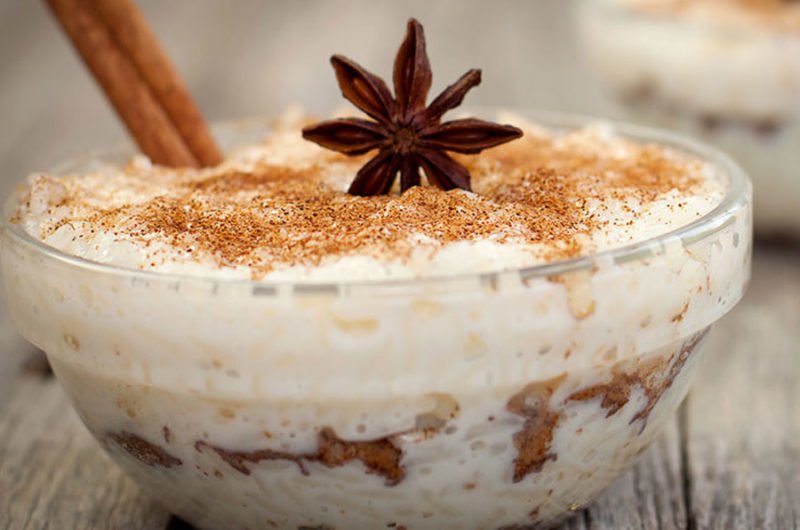
So Arroz con Leche is the Peruvian version of a rice pudding. Just like several other Peruvian foods, this version is just a tad sweeter than the rice pudding recipes you will find in other countries.
This simply yet delicious dessert is a Peruvian staple for after dinner treats.
You can generally find Arroz con leche in bakeries, supermarkets, restaurants and most Peruvian homes.
Where there is a Peruvian grandmother there is certainly an Arroz con Leche waiting to be prepared.
Frequently Asked Questions About Peruvian Foods
Is ceviche really raw fish?
Well this is actually not entirely true. The lemon juice used is acidic enough to cook the fish. This eliminates parasites as well.
Is Aji de Gallina a spicy dish?
No, aji de gallina gets its name because yellow hot peppers are used in its preparation however the seeds are removed and the rest is friend to remove most of the heat.
Do Peruvians really eat guinea pigs?
Yes guinea pigs are known as “Cuy” and they originated from the Andes region in South America. The native people bred them for food for several hundred years much before they were ever used as pets in more western countries. They are by all means a domesticated rodent, you won’t find wild cuy anywhere.
What does Alpaca taste like?
Alpaca meat tastes similar to elk meat. It is a very lean meat that can be consumed in steak form as well as stews and jerky.
What are anticuchos made out of?
Anticuchos are traditionally made from beef hearts. They are served as a typical street food in Peru.
Is Papa a la Huancaina from Lima?
Yes. Papa a la Huancaina comes from the Lima region of Peru.
Where is the Pisco sour from ?
Just like the spirit known as Pisco, the Pisco sour originates in Peru. There is even a town called Pisco to the South of Lima. This is where the Spirit gets its name from, the grapes come from the nearby city of Ica and are native to this arid region of the country.
How hot is the Rocoto pepper?
The Rocoto stands between 30,000 to 250,000 on the Scollville scale.


